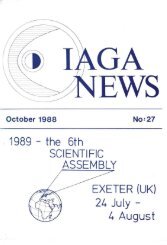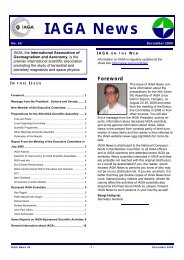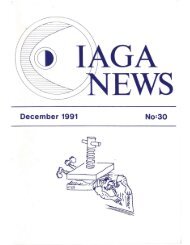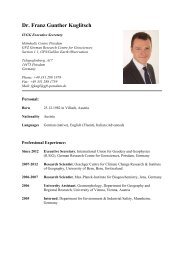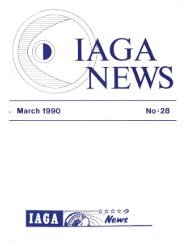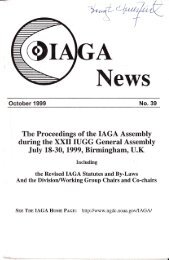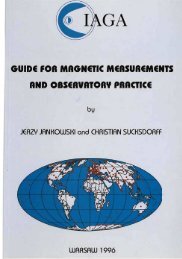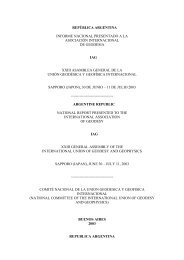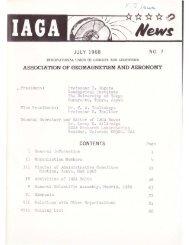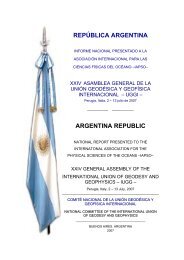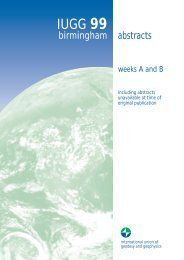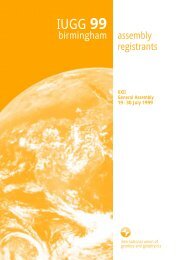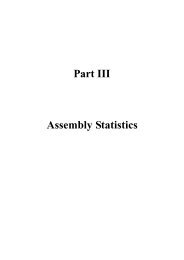IAGA News 2011 - IUGG
IAGA News 2011 - IUGG
IAGA News 2011 - IUGG
You also want an ePaper? Increase the reach of your titles
YUMPU automatically turns print PDFs into web optimized ePapers that Google loves.
No. 48 December <strong>2011</strong><br />
<strong>IAGA</strong>, the International Association of Geomagnetism<br />
and Aeronomy,<br />
is the premier international scientific association<br />
promoting the study of terrestrial<br />
andplanetarymagnetismandspacephysics<br />
Contents<br />
1 Message from the President 2<br />
2 The XXV th <strong>IUGG</strong> General Assembly 2<br />
2.1 Participation . . . . . . . . . . . . . . . 2<br />
2.2 Report of the Meetings of the <strong>IAGA</strong><br />
Conference of Delegates . . . . . . . . . 3<br />
2.2.1 First Conference of Delegates . . 3<br />
2.2.2 Second Conference of Delegates 5<br />
3 Reports on Meetings 7<br />
3.1 4 th <strong>IAGA</strong>/ICMA/CAWSES-II TG4<br />
Workshop . . . . . . . . . . . . . . . . 7<br />
3.2 3 rd International High Energy Particle<br />
Precipitation in the Atmosphere<br />
(HEPPA) Workshop . . . . . . . . . . . 7<br />
3.3 <strong>IAGA</strong>-III-Symposium Heliospheric<br />
Physics during and after a deep solar<br />
minimum . . . . . . . . . . . . . . . . . 8<br />
3.4 2 nd Biennial Meeting of the Latin-<br />
American Association of Paleomagnetism<br />
and Geomagnetism . . . . . . . 8<br />
3.5 The 1 st ICSU World Data System Conference<br />
. . . . . . . . . . . . . . . . . 9<br />
3.6 EMSEV Inter-Association Working<br />
Group <strong>2011</strong> activity . . . . . . . . . . . 9<br />
3.7 eGYAfrica Workshop, Accra 2010 . . . . 10<br />
4 Deceased <strong>IAGA</strong> Scientists 10<br />
5 General information about <strong>IAGA</strong> 12<br />
5.1 <strong>IAGA</strong> books series published by Springer 12<br />
5.2 <strong>IAGA</strong> guides . . . . . . . . . . . . . . . 13<br />
5.3 <strong>IAGA</strong> web . . . . . . . . . . . . . . . . 13<br />
5.4 <strong>IAGA</strong> contact . . . . . . . . . . . . . . 13<br />
<strong>IAGA</strong> on the Web<br />
Information on <strong>IAGA</strong> is regularly updated at<br />
the <strong>IAGA</strong> site:<br />
http://www.iugg.org/<strong>IAGA</strong>/<br />
Foreword<br />
This issue of <strong>IAGA</strong><br />
<strong>News</strong> contains information<br />
about<br />
the XXV th General<br />
Assembly of<br />
<strong>IUGG</strong> - Earth on<br />
the Edge: Science<br />
for a Sustainable<br />
Planet - held in Melbourne,<br />
Australia,<br />
27June-8July<strong>2011</strong>,<br />
and more specifically<br />
about the <strong>IAGA</strong> participation. Some major decisions<br />
taken during the Assembly by the <strong>IAGA</strong><br />
Conference of Delegates and the Executive Committee<br />
are reported. As the <strong>IUGG</strong> meeting represented<br />
the moment to renew the <strong>IAGA</strong> Executive<br />
Committee and President, I would like<br />
to take this opportunity to sincerely thank Eigil<br />
Friis-Christensen and the rest of the Executive<br />
Committee for the work done.<br />
Thisissuealsocontainsreportson<strong>IAGA</strong>activities<br />
of different kinds and provides information about<br />
deceased <strong>IAGA</strong> scientists. In its present form,<br />
<strong>IAGA</strong> <strong>News</strong> contains brief summaries of different<br />
activities and topics; the reader is referred to the<br />
<strong>IAGA</strong> website for more details.<br />
<strong>IAGA</strong> <strong>News</strong> is distributed – in its electronic form<br />
– to the National Correspondents in the Member<br />
Countries, to all <strong>IAGA</strong> officers and to <strong>IAGA</strong> scientists<br />
who have attended recent <strong>IAGA</strong> assemblies.<br />
Please free to distribute <strong>IAGA</strong> news around, especially<br />
to the national policy makers and leaders,<br />
whose decisions can affect the activities of <strong>IAGA</strong><br />
scientists.<br />
Mioara Mandea<br />
(Secretary-General)<br />
<strong>IAGA</strong> <strong>News</strong> <strong>2011</strong> – Page 1
1 Message from the President<br />
I am deeply honoured<br />
by the opportunity to<br />
serve the community<br />
as your President for<br />
the next four years.<br />
Our Association is<br />
in a healthy state,<br />
thanks to the tireless<br />
enthusiasm shown by<br />
the many who contribute<br />
to its activities,<br />
and above all to<br />
the tremendous leadership<br />
shown by my predecessor, Eigil Friis-<br />
Christensen. We all owe a deep debt of gratitude<br />
to him and the rest of the Executive Committee<br />
who have completed their terms of office.<br />
I would also like to record my personal thanks<br />
to those who have served as Division Officers or<br />
members of our other Committees; their dedication<br />
and commitment means that the business of<br />
the Association runs smoothly, and most of all,<br />
that we have successful scientific meetings.<br />
ThoseofuswhomadeittoMelbourneintheaustral<br />
winter were treated to a wide-ranging <strong>IUGG</strong><br />
General Assembly, efficiently run in a new conference<br />
centre which provided an excellent space<br />
for poster viewing and the exhibition, as well as<br />
plentyofvariedsizedroomsfororalpresentations.<br />
This gave us the chance to catch up with latest<br />
developments in our own research specialisms, as<br />
well as take in some of the more inter-disciplinary<br />
approachestoscienceofthenaturalenvironment.<br />
Being in Australia brought home the pertinence<br />
of the General Assembly’s theme – the country’s<br />
economy is booming, fuelled by the demand for<br />
natural resources (bringing with it eye-wateringly<br />
high prices for the visitor!), but the meeting followed<br />
not long after it suffered a series of natural<br />
disasters, including devastating floods, and<br />
some participants’ travel plans were affected by<br />
ash from a volcanic eruption in Chile. <strong>IUGG</strong> science<br />
is central to the understanding and mitigation<br />
of natural hazards, as well as resource exploration.<br />
Dan Baker gave an excellent and wellreceived<br />
Union Plenary lecture entitled ‘Assessing<br />
Solar and Solar-Terrestrial Influences as a Component<br />
of Earth’s Climate Change Picture’.<br />
We now look forward to a series of smaller meetings<br />
and workshops. I believe that this type<br />
of ‘bottom-up’ activity is essential to maintain<br />
the health of the <strong>IAGA</strong> community and its science<br />
and, even in these times of financial constraints,<br />
we must use our best endeavours to support<br />
them. They are a key way to get younger<br />
scientists – the ‘life blood’ for the next generation<br />
– and those from less developed nations involved<br />
in <strong>IAGA</strong>.<br />
At an Executive Committee meeting in Melbourne,<br />
<strong>IUGG</strong> took steps to form a Commission<br />
on Climatic and Environmental Change. This<br />
is seen as bringing together the Associations to<br />
add value to the activities of each individually<br />
on the topic; its success will depend critically on<br />
the synergy of ideas, problems and approaches<br />
generated between them. <strong>IAGA</strong> is also seeking<br />
to improve its connections and collaborations<br />
with other Associations. Specifically, we have<br />
approached IASPEI and IAVCEI concerning our<br />
participation in their Inter-Association CommissionsonVolcanoGeophysics,<br />
andthePhysicsand<br />
Chemistry of Earth Materials, where electromagnetic<br />
properties are of relevance. In addition, we<br />
havealsobegundiscussionswithIAMASconcerning<br />
holding a joint Assembly in 2017, recognising<br />
the strong scientific links between our two Associations<br />
regarding external magnetic fields.<br />
I’msurethenextfouryearswillpresentchallenges<br />
as well as successes. My aim is that <strong>IAGA</strong> will retain<br />
– and even expand – its relevance to all of<br />
us, so that the strength and productivity of our<br />
community continues to grow as we address the<br />
scientific questions and societal issues underpinning<br />
our work.<br />
Kathryn Whaler<br />
(President)<br />
2 The XXV th <strong>IUGG</strong> General<br />
Assembly, Melbourne<br />
2.1 Participation<br />
The Scientific Program of <strong>IUGG</strong><strong>2011</strong> ran from<br />
28 June through to 7 July <strong>2011</strong>. It involved more<br />
than 3600 scientists from 91 countries. Over the<br />
10 days of the Assembly, delegates participated<br />
in 198 Symposia and Workshops comprising 2831<br />
<strong>IAGA</strong> <strong>News</strong> <strong>2011</strong> – Page 2
oraland1926posterpresentations. Aswellasthe<br />
128 Symposia sponsored by the individual Associations<br />
and the 64 Joint Symposia sponsored by<br />
two or more Associations, there were nine Union<br />
Plenary Lectures by eminent scientists, and several<br />
speciality workshops held outside the core<br />
time of the Assembly.<br />
The total number of scientists attending the<br />
<strong>IUGG</strong>GeneralAssemblywasarecordhigh(3368);<br />
the distribution of the participants between the<br />
eight Associations and ‘Union and others’ was as<br />
follows:<br />
IACS 120<br />
IAG 370<br />
<strong>IAGA</strong> 536<br />
IAHS 423<br />
IAMAS 607<br />
IAPSO 323<br />
IASPEI 395<br />
IAVCEI 337<br />
Union and others 257<br />
The number of <strong>IAGA</strong> registrants was smaller than<br />
at the previous <strong>IUGG</strong> meeting in Perugia (669).<br />
However, the <strong>IAGA</strong> presence was remarkable, as<br />
<strong>IAGA</strong> scientists were involved in organising 4<br />
Union symposia, and led 5 Inter-Association symposia;<br />
the <strong>IAGA</strong>-only part of the meeting consisted<br />
of 16 symposia, sub-divided into several<br />
parts, spanning the full range of <strong>IAGA</strong> science<br />
interests. The <strong>IAGA</strong> programme began on 29<br />
July and ran through to the end of the General<br />
Assembly. As we move out of a period of exceptionally<br />
low and prolonged solar activity, space<br />
weather issues are going to become more important,especiallygivenmankind’sincreasingdependence<br />
on satellite technology; alongside this, radiation<br />
belt studies, and studies of the electromagnetic<br />
earth environment, are crucial. Both<br />
these themes featured strongly in the <strong>IAGA</strong> programme.<br />
Other highlights included results from<br />
theDecadeofGeopotentialResearch, particularly<br />
from the three low Earth orbiting magnetometry<br />
satellites Oersted, CHAMP and SAC-C, and anticipating<br />
the ESA multi-satellite mission Swarm;<br />
and the importance of data assimilation in geodynamo<br />
and related studies, incorporating techniques<br />
developed from other branches of <strong>IUGG</strong><br />
science, especially meteorology.<br />
Themeetingbroughtmanyoccasionforscientists<br />
todiscussallthesetopics, overbreaks, postersessions,<br />
and at the <strong>IAGA</strong> dinner, splendidly organised<br />
by Past-President Charles Barton!<br />
2.2 Report of the Meetings of the <strong>IAGA</strong><br />
Conference of Delegates<br />
2.2.1 First Conference of Delegates<br />
Saturday, July 2, <strong>2011</strong><br />
The following reports were presented, the main<br />
items of these reports being summarised in the<br />
following.<br />
Report of the President Eigil Friis-Christensen<br />
Report of the Secretary- Mioara Mandea<br />
General<br />
Report of the Finance Com- Michel Menvielle<br />
mittee<br />
Report of the Nominating David Kerridge<br />
Committee<br />
Report on eGy Africa Charles Barton<br />
Report on preparations for Harald Böhnel<br />
the 2013 <strong>IAGA</strong> Scientific<br />
Assembly<br />
In Memorium<br />
The President announced that the following <strong>IAGA</strong> scientists<br />
had died since the previous <strong>IAGA</strong> Assembly in<br />
Toulouse and asked for a minute’s silence in their honour:<br />
Jean-Paul Villain France 2008<br />
Pembroke J. Hart USA 2008<br />
Richard Doell USA 2008<br />
Peter M. McGrego Australia 2008<br />
Roy Piggott UK 2008<br />
Martin Pomerantz USA 2008<br />
Ulrich Schmucker Germany 2008<br />
Jules Aarons USA 2008<br />
Jim Horwitz USA 2009<br />
Mario Acuña USA 2009<br />
Hugo Fournier Argentina 2009<br />
Peter Weidelt Germany 2009<br />
Luiz Rijo Brazil 2009<br />
Mark Berdichevsky Russia 2009<br />
<strong>IAGA</strong> <strong>News</strong> <strong>2011</strong> – Page 3
David Rankin Canada 2009<br />
Kazuo Nagashima Japan 2010<br />
Tsutom Tamao Japan 2010<br />
Takashi Oguti Japan 2010<br />
Vadim Golovkov Rusia 2010<br />
Keith Cole Australia 2010<br />
Valery Troitskaya Australia 2010<br />
Paul Kintner USA 2010<br />
B.P. Singh India <strong>2011</strong><br />
B.J. Srivastava India <strong>2011</strong><br />
Ingrid Sandahl Sweden <strong>2011</strong><br />
Ian Gough Canada <strong>2011</strong><br />
Wilfried Schröder Germany <strong>2011</strong><br />
A special homage was given to Valery Troitskaya and<br />
Keith Cole by the <strong>IAGA</strong> President, Eigil Friis-Christensen,<br />
at the beginning of Dan Baker’s <strong>IUGG</strong> Plenary lecture.<br />
Executive meetings (<strong>IAGA</strong> and <strong>IUGG</strong>)<br />
Over the last two years the Executive Committee met formally<br />
several times (August 2009, Sopron - (4), and June<br />
<strong>2011</strong>, Melbourne - (4)), and held a few informal meetings<br />
when many members were attending other meetings (December<br />
2009, S.F., USA, AGU fall meeting; July 2010,<br />
Berlin, Germany, SCOSTEP/COSPAR; December 2010,<br />
S.F., USA, AGU fall meeting).<br />
<strong>IAGA</strong> Awards<br />
<strong>IAGA</strong> Award for Interdisciplinary Achievements -<br />
Shen Kuo The Award aims to recognize and acknowledge<br />
outstanding scientists whose activities and achievements<br />
cross several fields of research covered by <strong>IAGA</strong>.<br />
Shen Kuo 沈括 (1031-1095)<br />
Shen Kuo was a Chinese scientist<br />
and statesman of the<br />
Song Dynasty (960-1279). His<br />
talents and contributions extended<br />
to almost every field of<br />
learning. Hewasagiftedmathematician,<br />
astronomer, geologist<br />
and poet. He provided<br />
thefirstaccountofasuspended<br />
magnet compass; the concept<br />
of magnetic poles; understanding<br />
of declination (magnetic poles are not at geographic<br />
poles); the concept of true north; and the discovery of<br />
dip.<br />
Eligibility Candidates for the Award should be internationally<br />
recognized scientists active in several fields of <strong>IAGA</strong>related<br />
research. The candidates should be nominated by<br />
at least one of the following:<br />
• 3 Working Groups from at least 2 Divisions<br />
• 2 Divisions<br />
• 1 Division and 1 Interdivisional Commission.<br />
The nomination may be supported by other scientific bodies<br />
outside <strong>IAGA</strong> with research activities related to those<br />
of <strong>IAGA</strong>. Nominations should include a summary of research<br />
activities of the candidate, emphasizing their interdisciplinary<br />
character and highlighting the impact of<br />
the nominee’s activities across the fields of research.<br />
Procedure Nominations should be submitted to the<br />
Secretary-General of <strong>IAGA</strong> during the <strong>IAGA</strong> Assembly,<br />
at latest before the last Executive Committee meeting.<br />
<strong>IAGA</strong> Executive Committee will, upon approval, grant the<br />
Award at an official occasion, usually the opening ceremony<br />
of the forthcoming <strong>IAGA</strong> Assembly.<br />
<strong>IAGA</strong> Medal for Outstanding Long Service<br />
The very last existing <strong>IAGA</strong><br />
Medal for Outstanding Long<br />
Service (see photo) has been<br />
awarded. Thenewseriesofthis<br />
medal is under design.<br />
The President announced the<br />
award of the ‘<strong>IAGA</strong> Medal in<br />
Recognition of Valued Services<br />
to the <strong>IAGA</strong> Community over<br />
Many Years’ to Bengt Hultqvist, with a summary of his<br />
long activities within <strong>IAGA</strong> given by the President.<br />
Young Scientist Presentation Awards<br />
These awards are made to younger scientists whose research<br />
and presentation of it at topical meetings are<br />
judged to be the best. Certificates were presented by<br />
the President to the winners of <strong>IAGA</strong>’s ‘Young Scientists<br />
<strong>IAGA</strong> <strong>News</strong> <strong>2011</strong> – Page 4
Presentation Award’. Three of five winners were present<br />
at the ceremony, and Springer was warmly thanked for<br />
providing financial support (registration fee) for one of<br />
them.<br />
Annika Seppälä – High Energy Particle Precipitation in<br />
the Atmosphere (HEPPA) Workshop<br />
Gilda Currenti – International EMSEV-2010 Workshop on<br />
Electromagnetic Studies of Earthquakes<br />
Eva Macusova – 4th VLF/ELF Remote Sensing of the<br />
Ionosphere and Magnetosphere (VERSIM) Workshop.<br />
<strong>IAGA</strong> financial situation<br />
The Finance Committee analysed the <strong>IAGA</strong> financial situation<br />
and concluded that at the beginning of <strong>2011</strong>, the<br />
total amount of <strong>IAGA</strong> funds was on the order of three<br />
times the total expenditure for a year during which there<br />
is an Assembly.<br />
The Finance Committee proposed that this ratio should<br />
be maintained, the current policy of limitation of expenditures<br />
related to administration should be continued, and<br />
that the support to science should be increased, with the<br />
objective of an equilibrium between yearly income and expenditure.<br />
Changes to the Statutes and By-Laws<br />
Changes to the Statutes and By-Laws (SBL) were proposed<br />
by Pavel Hejda, National Correspondant for the<br />
Czech Republic.<br />
He proposed to change Statute 15 (Modification of the<br />
Status), Statute 16 (Modification of the By-Laws), and<br />
By-Law 4 (Honorary Membership of <strong>IAGA</strong>). The changes<br />
were in line with the <strong>IUGG</strong> Statues regarding this issue.<br />
The changes were accepted unanimously, and they are<br />
available on the <strong>IAGA</strong> web.<br />
2.2.2 Second Conference of Delegates:<br />
Wednesday, July 6, <strong>2011</strong><br />
Thirty of the thirty-six accredited Chief Delegates were<br />
present at the meeting so it was quorate. During this<br />
meeting the Secretary-General reported on the three Executive<br />
Committee meetings during the <strong>IUGG</strong> GA. She<br />
also reported on the skeleton programme for the <strong>IAGA</strong> SA<br />
built on inputs from Divisions. This programme planning<br />
will be defined with the Division leaders and a programme<br />
of about the same size as in <strong>2011</strong> is expected for 2013.<br />
Resolutions<br />
Draft resolutions from were presented by the Chair of the<br />
Resolutions Committee, Kathy Whaler. They were accepted<br />
and are:<br />
<strong>IAGA</strong> Resolution 1 – Résolution AIGA no1<br />
(Division I)<br />
<strong>IAGA</strong>,<br />
considering<br />
the value of continuity in magnetic satellite missions to<br />
increase our knowledge of Earth dynamics;<br />
noting<br />
that no successor to ESA’s Swarm mission yet exists;<br />
urges<br />
the development of missions by national and international<br />
agencies to fill this void for the period 2016 onwards.<br />
<strong>IAGA</strong> <strong>News</strong> <strong>2011</strong> – Page 5
AIGA,<br />
considérant<br />
l’importancedelacontinuitéentrelesmissionssatellitaires<br />
magnétiques pour l’amélioration de notre compréhension<br />
de la dynamique terrestre;<br />
notant<br />
qu’aucune mission n’est actuellement définie pour<br />
succéder à la mission Swarm de l’ESA;<br />
exhorte<br />
les agences nationales et internationales à développer de<br />
nouvelles missions pour combler cette lacune à partir de<br />
2016.<br />
<strong>IAGA</strong> Resolution 2 – Résolution AIGA no 2<br />
(Division I)<br />
<strong>IAGA</strong>,<br />
considering<br />
the significance of experimental data necessary for understanding<br />
the magnetic field and magnetic properties of<br />
Earth and Earth-related materials;<br />
noting<br />
the increasing demands on technical performance of upto-date<br />
experimental facilities, and associated cost increases;<br />
acknowledges<br />
the scientific value of open and free access to sophisticated<br />
experimental facilities offered by certain research<br />
institutions.<br />
AIGA,<br />
considérant<br />
la valeur intrinsèque des données expérimentales<br />
nécessaires à la compréhension du champ magnétique et<br />
des propriétés magnétiques de la Terre et de ses matériaux<br />
compositionnels ;<br />
notant<br />
les exigences croissantes en ce qui concerne les performances<br />
techniques d’installations expérimentales de<br />
pointe, et l’augmentation des coûts associés ;<br />
reconnaît<br />
la valeur scientifique de l’accès ouvert et gratuit à des<br />
installations expérimentales sophistiquées, offert par certains<br />
instituts de recherche.<br />
<strong>IAGA</strong> Resolution 3 – Résolution AIGA no 3<br />
(Division V)<br />
<strong>IAGA</strong>,<br />
noting<br />
the importance of the Dst index for various applications<br />
including geomagnetic field modeling, space-weather and<br />
-climate studies and detection of local anomalous variations,<br />
recognizing<br />
that the absolute accuracy of the data from the contributing<br />
observatories, Kakioka, Honolulu, San Juan,<br />
Hermanus and Alibag, is essential,<br />
recommends<br />
that all agencies operating these geomagnetic observatories<br />
continue to support both absolute and variation<br />
measurements to maintain the required level of accuracy.<br />
AIGA,<br />
notant<br />
l’importance de l’indice Dst pour de multiples applications<br />
etenparticulierlamodélisationduchampgéomagnétique,<br />
les études de météorologie et de climatologie spatiale, et<br />
la détection de variations locales anormales,<br />
reconnaissant<br />
que la précision absolue des données des observatoires de<br />
Kakioka, Honolulu, San Juan, Hermanus et Alibag, qui<br />
contribuent au calcul de l’indice Dst, est essentielle,<br />
recommande<br />
que toutes les agences en charge de ces observatoires<br />
magnétiques poursuivent leur soutien aux mesures absolues<br />
et aux mesures des variations pour maintenir le<br />
niveau de précision requis pour le calcul de l’indice.<br />
<strong>IAGA</strong> Resolution 4 – Résolution AIGA no 4<br />
(Division V)<br />
<strong>IAGA</strong>,<br />
considering<br />
the importance of homogeneous magnetic anomaly data<br />
coverage for global geological studies,<br />
urges<br />
the owners of airborne and marine magnetic anomaly data<br />
sets, in particular from equatorial areas and the southern<br />
hemisphere, to release them into the public domain as<br />
soon as possible.<br />
AIGA,<br />
considérant<br />
l’importance, pour les études géologiques globales, de la<br />
couverture spatiale homogène des données d’anomalies<br />
magnétiques,<br />
exhorte<br />
les détenteurs d’ensembles de données d’anomalies<br />
magnétiques aéroportées ou marines, en particulier pour<br />
les zones équatoriales et pour l’hémisphère sud, à rendre<br />
dès que possible ces données disponibles dans le domaine<br />
public.<br />
Election of Officers for the <strong>2011</strong> - 2015 Quadrennium<br />
The election process was conducted usingthe scheme proposed<br />
by David Kerridge, Chairman of the Nominating<br />
Committee, andapprovedbytheConferenceofDelegates.<br />
The newly elected Executive Committee members are:<br />
President: Kathryn Whaler (UK)<br />
Vice-President: Eduard Petrovsky (Czech Republic)<br />
Members:<br />
Archana Bhattacharyya (India)<br />
Iver Cairns (Australia)<br />
Jeffrey Forbes (USA)<br />
Toshihiko Iyemori (Japan)<br />
Monika Korte (Germany)<br />
<strong>IAGA</strong> <strong>News</strong> <strong>2011</strong> – Page 6
Laszlo Szarka (Hungary)<br />
Andrew Yau (Canada)<br />
New Leadership of Divisions and Commissions<br />
The Conference of Delegates found the geographical distribution<br />
of proposed post-holders to be satisfactory and<br />
accepted the list of new leaders of the Divisions and Commissions<br />
proposed by the Executive Committee on the basis<br />
of information from the Business Meetings.<br />
Division I:<br />
Chair: Gauthier Hulot (France)<br />
Co-Chair: Yasuo Ogawa (Japan)<br />
Division II:<br />
Chair: Dora Pancheva (Bulgaria)<br />
Co-chair: Paulo R. Fagundes (Brazil)<br />
Division III:<br />
Chair: Larry Kepko (USA)<br />
Co-chair: Clare Watt (Canada)<br />
Division IV:<br />
Chair: Xing Li (UK)<br />
Co-chair: John Richardson (USA)<br />
Division V:<br />
Chair: Alan Thomson (UK)<br />
Co-chair: Pieter Kotzé (South Africa)<br />
Interdivisional Commission on Developing<br />
Countries:<br />
Chair: Inez S. Batista (Brazil)<br />
Co-chair: Pieter Kotzé (South Africa)<br />
Interdivisional Commission on History:<br />
Chair: Ronald Doel (USA)<br />
Co-chair: David Boteler (Canada)<br />
The list of Working Groups leaders are available on<br />
the <strong>IAGA</strong> page: http://www.iugg.org/<strong>IAGA</strong>/iaga_<br />
pages/science/sci_structure.htm.<br />
Liaison persons<br />
<strong>IAGA</strong> Executive Committee nominates the following scientists<br />
to be the liaison persons with different bodies:<br />
COSPAR: Eric Donovan (Canada)<br />
SCOSTEP: Vladimir Kuznetsov (Russia)<br />
<strong>IUGG</strong> Commissions:<br />
SEDI: Cathy Constable (USA)<br />
Dominique Jault (France)<br />
CGM: Matthias Holschneider (Germany)<br />
GRC: David Boteler (Canada)<br />
Alan Thomson (UK)<br />
UCDI: Anatoly Soloviev (Russia)<br />
Peter Fox (USA)<br />
3 Reports on Meetings: <strong>IAGA</strong>-<br />
Sponsored or with <strong>IAGA</strong> interest<br />
3.1 4 th <strong>IAGA</strong>/ICMA/CAWSES-II TG4<br />
Workshop on Vertical Coupling in the<br />
Atmosphere/Ionosphere System<br />
February 14-18, Prague (Czech Republic)<br />
The 4 th <strong>IAGA</strong>/ICMA/CAWSES-II TG4 Workshop on<br />
“Vertical Coupling in the Atmosphere/Ionosphere System”<br />
was held at the Hotel Globus located in a quiet<br />
Prague district, Czech Republic, February 14-18, <strong>2011</strong>.<br />
The meeting was attended by a total of 75 senior and<br />
young scientists from 16 countries. During the 5 days<br />
of the workshop the participants presented 79 papers,<br />
of which 16 were solicited presentations. Before the<br />
official opening of the workshop there were two public/educational<br />
lectures (by Esa Turunen and Mike Taylor)<br />
attended mainly by students from Prague grammar<br />
schools and University. The aim of this workshop was<br />
not only to address the physics behind the forcing mechanisms<br />
that originate in the lower atmosphere and play an<br />
important role on the upper atmosphere and ionosphere,<br />
but also to show the solutions of some of the problems<br />
which were only formulated during the 3 rd <strong>IAGA</strong>/ICMA<br />
Workshop held five years ago in Varna, Bulgaria. The<br />
meeting was designed so that research experts from both<br />
the middle and upper neutral atmosphere and ionosphere<br />
communities came together in order to present their work<br />
and assess/debate ongoing issues relating to the theoretical,<br />
modelling and observational aspects of all kinds of<br />
processes which transfer energy and momentum from the<br />
loweratmospheretotheupperatmosphereandionosphere<br />
andviceversa. ThepresentationsatthisWorkshopwillbe<br />
published in a special issue of JASTP. The team of Guest<br />
Editors includes: Dora Pancheva (Geophysical Institute,<br />
BAS, Sofia, Bulgaria), Petra Koucká Kníˇzová (Institute<br />
of Atmospheric Physics, CAS, Prague, Czech Republic),<br />
Kazuo Shiokawa (Solar-Terrestrial Environment Laboratory,<br />
Nagoya University, Japan) and Weixing Wan (Institute<br />
of Geology and Geophysics, Chinese Academy of<br />
Sciences, China).<br />
Petra Koucká Kníˇzová<br />
Chair of the Organizing Committee<br />
3.2 3 rd International High Energy Particle<br />
Precipitation in the Atmosphere<br />
(HEPPA) Workshop<br />
May 9-11, Granada (Spain)<br />
In recent years, many new satellite instruments capable of<br />
polar region observations have been launched. This, together<br />
with recent state-of-the-art modeling efforts, has<br />
provided unique opportunities to study the effects of energetic<br />
particle precipitation (EPP) on the atmosphere.<br />
The Finnish Meteorological Institute organized the 1st International<br />
High Energy Particle Precipitation in the Atmosphere<br />
(HEPPA) Workshop, 28-30 May, 2008, and the<br />
<strong>IAGA</strong> <strong>News</strong> <strong>2011</strong> – Page 7
NationalCenterforAtmosphericResearchinBoulder,Colorado,<br />
USA organized the second one. Both workshops<br />
were so successful that we organized the 3rd International<br />
HEPPA Workshop on 9-11 May <strong>2011</strong> (HEPPA-<strong>2011</strong>) in<br />
Granada (Spain) hosted by Instituto de Astrofísica de Andalucía<br />
(IAA) of the Spanish Research Council (CSIC).<br />
It was jointly sponsored by IAA, CSIC, <strong>IAGA</strong>, and the<br />
Spanish Ministry for Research and Innovation (MICINN).<br />
Like the other two workshops, HEPPA-<strong>2011</strong> focused on<br />
observational and modeling studies of atmospheric and<br />
ionospheric changes caused by EPP and included a new<br />
session on climate and EPPs.<br />
HEPPA-<strong>2011</strong> brought together 64 participants from<br />
Canada, Chile, Finland, Germany, Italy, Japan, Norway,<br />
Russia, South Africa, Spain, Sweden, Switzerland, UK<br />
and USA. The workshop consisted of invited tutorials that<br />
were targeted at a level to bring together people from various<br />
disciplines, as well as invited talks, contributed talks,<br />
and contributed posters. A total of 51 oral and 15 poster<br />
presentations were given.<br />
The third HEPPA model/measurement inter-comparison<br />
working meeting was also held on Thursday 12 May <strong>2011</strong>.<br />
Tutorialsandinvitedtalkswerepresentedontopicsincluding<br />
the Earth’s radiation belts, solar and galactic sources<br />
of energetic particles, cosmic rays, satellite measurements<br />
of energetic particles, sub-ionospheric VLF and measurements<br />
of energetic particles, effects of EPPs on the thermosphere/ionosphere,<br />
mesosphere and stratosphere, processes<br />
that govern vertical coupling in the atmosphere,<br />
solar influences on climate and on future measurements.<br />
Manuel López-Puertas<br />
On behalf of the Scientific Committee<br />
3.3 <strong>IAGA</strong>-III-Symposium Heliospheric<br />
Physics during and after a deep solar<br />
minimum<br />
November 13-17, Luxor (Egypt)<br />
The goal of the Symposium was to maintain the momentum<br />
generated by previous Symposia by organizing this<br />
further Symposium entitled ‘Heliospheric Physics during<br />
and after a deep solar minimum’ at which the global communitycouldagainsharetheirlatestresearchworks,cooperate<br />
from different fields of solar and space research, and<br />
discuss the consequences and effects of a deep solar minimum.<br />
The Symposium focused on the fundamental problems<br />
of Solar physics and the Solar Cycle and their related<br />
physical effects on the Space Environment including the<br />
outer atmosphere and interplanetary space. The presentations<br />
and discussions at this Solar and Space Weather<br />
symposium also focused on identifying the highest priorities<br />
needed for operational services that can guide future<br />
research, and on identifying new high-value capabilities<br />
that can be translated into operations.<br />
The scientific topics presented at the Symposium were:<br />
Solar cycle prediction techniques; Source regions of the<br />
solar wind at solar activity minimum and associated modeling;<br />
The impact of prolonged solar minima on global<br />
climate change; Solar Wind at the time of solar minimum<br />
and of the rising phase of cycle 24; Physics, dynamics,<br />
and behavior of the Sun-Earth system over the 11-years<br />
solar cycle; Particle acceleration near the Sun and in the<br />
Heliosphere under quiet and active solar conditions; The<br />
Heliosphere in the local interstellar medium; and Solar<br />
variabilities, Space Weather and geo-hazards. The <strong>IAGA</strong>-<br />
III Symposium participants were 48 participants from 21<br />
countries distributed all over the world: Bulgaria, Cyprus,<br />
Egypt, France, Germany, Greece, India, Iran, Italy, Kazakhstan,<br />
Korea, Morocco, Mexico, Nigeria, Russia, Saudi<br />
Arabia, South Africa, Ukraine, USA, and Zambia.<br />
During the meeting eight sessions were organised, 13 papers<br />
being review or invited lectures. In addition, 26 papers<br />
were accepted as oral contributions and 11 as poster<br />
contributions. The articles resulting from these presentations<br />
and posters, upon review, will be published in a<br />
special issue of the Cairo University Journal of Advanced<br />
Research, an Elsevier publication.<br />
Ahmed Abdel Hady<br />
On behalf of the Scientific Committee<br />
3.4 Second Biennial Meeting of the Latin-<br />
American Association of Paleomagnetism<br />
and Geomagnetism (Latin-<br />
Mag)<br />
November 23-26, Tandil (Buenos Aires, Argentina)<br />
The Second Biennial Meeting of the Latin-American Association<br />
of Paleomagnetism and Geomagnetism (Latin-<br />
Mag) was held in Tandil (Buenos Aires, Argentina), on<br />
November 23-26, <strong>2011</strong>. This was a great opportunity for<br />
updatingthelatestscientificadvancesinpaleomagnetism,<br />
geomagnetism, rock magnetism, archeomagnetism, magnetostratigraphy,<br />
environmental magnetism, magnetofabrics<br />
and magnetic surveying; promoting the meeting of<br />
colleagues in a pleasant and friendly environment in order<br />
to enhance personal and institutional ties. Although<br />
the main objective of this meeting is related to Latin-<br />
American research issues, all colleagues who are working<br />
in similar international matters were very welcome.<br />
LATINMAG brought together 86 participants from Argentina,<br />
Brazil, Bulgaria, Czech Republic, Chile, Colombia,<br />
France, Italy, Germany, Mexico, Spain, Uruguay, USA<br />
and Venezuela. It was important that our meeting was attractive,<br />
in particular to young researchers: 31 graduate<br />
and undergraduate students took part in the conference.<br />
The venue was the University Cultural Center of the National<br />
University of the Centre of Buenos Aires Province,<br />
suitably located in the downtown of Tandil, a beautiful<br />
city in the heart of the Argentine Pampas.<br />
The scientific part of the conference consisted of four<br />
sessions (Session A: Geomagnetism - Geophysics Methods,<br />
Session B: Paleomagnetism - Tectonics, Session C:<br />
Archeomagnetism, Paleointensity, Paleosecular Variations<br />
and Session D: Rock Magnetism - Environmental Magnetism),<br />
which included 46 oral (15 invited and 31 regular)<br />
and 61 poster presentations. Two half-day courses<br />
<strong>IAGA</strong> <strong>News</strong> <strong>2011</strong> – Page 8
tookplaceduringthemeeting,givenbyLeonardoSagnotti<br />
and Edgardo Cañón-Tapia. Martin Chadima delivered two<br />
short courses on application of magnetic susceptibility as<br />
a function of temperature, field and frequency and recent<br />
advances in anisotropy of magnetic remanence. A special<br />
talk about the MagIC System was given by Monika Korte<br />
and Ricardo Trindade. In parallel, three conferences<br />
open to the whole community, in particular, students of<br />
high school age, were delivered by Avto Gogichaishvili,<br />
Augusto Rapalini and Leda Sánchez.<br />
The scientific activities were accompanied by a rich social<br />
program, including beer-tasting and a city tour to<br />
the most important tourist sites in Tandil. In the closing<br />
ceremony, the participants enjoyed a great barbecue on<br />
a traditional Argentine farm and also a tango show, especially<br />
prepared for the occasion. In this ceremony, Dr.<br />
Juan Vilas was awarded with the ‘Trajectory Prize’ from<br />
LatinMag for his outstanding contribution to the field of<br />
geophysics and 2 students got Certificates of Outstanding<br />
Student presentation (Jairo Savian, Brazil and Ceclia<br />
Weidmann, Argentina).<br />
The Proceedings with all extended abstracts of the meeting<br />
were published as volume 1, number 2 of the electronic<br />
journal LatinMag Letters, an open and free access<br />
journal published by the Latin American Association<br />
of Paleomagnetism and Geomagnetism (http://www.<br />
geofisica.unam.mx/LatinmagLetters/LL11-0102P/<br />
LL11-01P-idx.htm). Financial support, provided by<br />
<strong>IAGA</strong>, was greatly appreciated, and used to support<br />
the participation of ten young scientists from developing<br />
countries, which included travel expenses and waiving<br />
of registration fees.<br />
Claudia Gogorza<br />
On behalf of the Organizing Committee<br />
3.5 The 1 st ICSU World Data System Conference<br />
The 1 st ICSU World Data System Conference – Global<br />
Data for Global Science – was held on September 3-6,<br />
<strong>2011</strong> at Kyoto University, Kyoto, Japan. This conference<br />
was the first international meeting of the WDS to provide<br />
an opportunity to receive opinions, comments and<br />
suggestions from scientific communities (data users) and<br />
about other international data systems to establish the<br />
active plan of WDS. About 155 participants from over 22<br />
countries attended. Participants included representatives<br />
of data centres, data scientists and engineers working in a<br />
varietyoffields, aswellasdatapublishers. Theconference<br />
was held 6 months after the <strong>2011</strong> Tohoku earthquake. In<br />
this exceptional context a session on disaster data was<br />
organized in collaboration with the ICSU co-sponsored Integrated<br />
Risk and Disaster Research (IRDR) programme<br />
and the Disaster Prevention Research Institute at Kyoto<br />
University.<br />
The 59 talks and over 70 poster papers enabled the<br />
nascent WDS community to engage in effective scientific<br />
collaboration and provided a constructive forum for lively<br />
exchanges of views and ideas. Important feedback was<br />
also provided to the WDS Scientific Committee during<br />
a Members’ and Partners’ open forum. The conference<br />
was also an opportunity to initiate a dialogue with WDS<br />
stakeholders and important partners such as the Committee<br />
on Data for Science and Technology (CODATA)<br />
and the International Oceanographic Data and Information<br />
Exchange (IODE). The conference was sponsored by<br />
the ICSU WDS International Programme Office hosted<br />
by the NICT, the ICSU/WDS Scientific Committee, the<br />
Science Council of Japan, and the Graduate School of<br />
Science, Kyoto University. More details can be found on<br />
the conference website: http://wds-kyoto-<strong>2011</strong>.org<br />
Iyemori Toshihiko<br />
3.6 EMSEV Inter-Association Working<br />
Group <strong>2011</strong> activity<br />
On behalf of <strong>IUGG</strong>, the EMSEV Inter-Association Working<br />
Group (WG) promotes ‘Electromagnetic Studies of<br />
Earthquakes and Volcanoes’. The EMSEV WG is primarily<br />
supported by <strong>IAGA</strong>, IAVCEI and IASPEI, because<br />
our research needs expertise in the fields of electromagnetism,<br />
wave propagation through Earth and ionosphere,<br />
physics of the Earth, physics of fault rupture<br />
and volcanic eruptions, geochemistry, hydrogeology, laboratory<br />
experiments, complex data processing and modelling.<br />
Information on EMSEV activities can be found<br />
at http://www.emsev-iugg.org/emsev/. EMSEV priorities<br />
are carried out in three main domains. The first<br />
priority is to organize international and regional meetings,<br />
and host EM sessions at international conferences<br />
in which new findings and recent studies are debated<br />
and endorsed. Every year, EMSEV’s community holds<br />
a business meeting during which research, activities and<br />
projects are discussed and new research topics are taken<br />
up. In addition, EMSEV organizes every two years international<br />
meetings, in which research from emerging<br />
countries are presented. The next EMSEV meeting will<br />
be held in Japan on September 30 - October 4, 2012<br />
(seehttp://www.emsev-iugg.org/emsev2012/ for details).<br />
The second priority is to promote strongly international<br />
cooperation between individuals and research teams at<br />
the international scale. EMSEV encourages new research<br />
on earthquakes and volcanic eruptions, builds relationships<br />
between Research Institutes and EMSEV members,<br />
and signs Memorandums of Understanding (MOU)<br />
which insure long term cooperation and support, such as<br />
those with the Philippines Institute of Volcanology and<br />
Seismology (PHIVOLCS, http://www.phivolcs.dost.<br />
gov.ph/) in Volcanology and with the International Geophysical<br />
Research Centre and Bishkek Research Station in<br />
Kyrgyzstan (http://www.gdirc.ru/en) on the physics<br />
of earthquakes.<br />
The third domain in which EMSEV is dynamic may be<br />
called ‘EMSEV research and education activities’. The<br />
objective is to develop fundamental and applied research<br />
with developing countries and large Institutes on topics<br />
<strong>IAGA</strong> <strong>News</strong> <strong>2011</strong> – Page 9
which can lead to new findings and progress on risk mitigationinVolcanologyandonEarthquakes.<br />
Twoprograms<br />
are now ongoing in the Philippines and in Kyrgyzstan.<br />
J. Zlotnicki, M.J.S. Johnston, T. Nagao<br />
3.7 eGYAfrica Workshop, Accra 2010<br />
eGYAfrica evolved from the Electronic Geophysical Year<br />
(www.egy.org) in response to the need for better Internet<br />
connectivity for research and education in Africa<br />
i.e., to help reduce the digital divide. The objective is<br />
to strengthen research and education in Africa to serve<br />
national interests and to increase African participation in<br />
international science.<br />
The two-day eGYAfrica Workshop and planning meeting,<br />
held in Accra in November 2010, was supported through<br />
a grant from <strong>IUGG</strong>, together with additional support from<br />
<strong>IAGA</strong>. Seven African countries were represented. The first<br />
day focussed on Internet issues in Africa, particularly the<br />
digital divide, the rapid expansion of fibre-optic cabling<br />
around and within Africa, and the development of National<br />
Research and Education Networks (NRENs).<br />
The PingER Project that measures end-to-end Internet<br />
performance shows, despite this impressive progress, that<br />
a digital divide persists in Africa that hampers progress.<br />
Limitations at the institutional level are often an important<br />
factor.<br />
The second day was devoted to eGYAfrica review and<br />
planning. A solid working relationship was established<br />
with the Association of African Universities (Boubakar<br />
Barry, Head of the NREN Unit), and with ICSU’s Regional<br />
Office for Africa in Pretoria (Daniel Nyanganyura).<br />
Workshop participants were pleased with the progress of<br />
eGYAfrica and were enthusiastic about its future; officers<br />
were elected for the eGYAfrica Committee for the next 2<br />
years, andamonographbasedonthethemesofeGYAfrica<br />
and the developments of NRENs in Africa is planned. A<br />
key activity of eGYAfrica is to establish national groups<br />
who will seek to influence decision-makers. This is is currently<br />
being pursued in Cote d’Ivoire, Ethiopia, Ghana,<br />
Kenya, Nigeria, Rwanda, Senegal, and South Africa. The<br />
importance of working through existing groups when possible<br />
was emphasized.<br />
A full report about the Workshop is at:<br />
http://dl.dropbox.com/u/31851729/eGYAfrica%<br />
20Workshop2010.doc<br />
V. Chukwuma, A. Mebrahtu, C. Barton<br />
4 Deceased <strong>IAGA</strong> Scientists<br />
Ian Gough (1922 - <strong>2011</strong>)<br />
Ian Gough was born on 20<br />
June 1922 in Port Elizabeth,<br />
South Africa. He received<br />
a B.Sc and M.Sc. from<br />
Rhodes University (in 1943<br />
and 1947, respectively), and<br />
a Ph.D. from the University<br />
of Witwatersrand in<br />
1953. From 1947 to 1958<br />
he worked as a researcher<br />
at the South African Council<br />
for Scientific and Industrial Research, before moving<br />
to academe where he spent the rest of his career. In<br />
the years 1958-1963 he was at the University College of<br />
Rhodesia and Nyasaland (in what is now Harare, Zimbabwe),<br />
followed by a short period (1964-1966) at the<br />
Southwest Center for Advanced Studies in Dallas, Texas.<br />
Thereafter, he moved to the University of Alberta in Edmonton,<br />
Canada where he remained on the faculty until<br />
his retirement in 1988.<br />
Ian had a rich and productive research career in his chosen<br />
field of geophysics. He published more than 100 papers in<br />
first-class international scientific journals, and made seminal<br />
contributions to a very wide range of topics in the<br />
earth sciences. He belonged to a generation of scientists<br />
who approached scientific work very much from first principles.<br />
Given a need to bring observations to bear on a<br />
particular problem, he set about designing, constructing,<br />
and operating the necessary apparatus. I well remember<br />
him preparing the unique Gough-Reitzel magnetometers<br />
foranupcomingfieldseason–rowsofverticalmetaltubes<br />
standingtoattentionlikeasquadronofsoldiersonparade.<br />
And each one containing a sensitive magnet system and<br />
an ingenious home-made camera. He was simultaneously<br />
commanding officer, quartermaster, and chief mechanic.<br />
One thinks of Newton polishing mirrors for his own telescope,<br />
or of Faraday co-opting a giant link from an anchor<br />
chain to construct his electromagnet. Deployed as arrays<br />
across wide stretches of North America, South Africa, and<br />
Australia,Ian’smagnetometersrevealedhithertounknown<br />
structures in the Earth’s crust, such as an ancient platetectonic<br />
boundary stretching more than 1000 km through<br />
the Canadian Shield and down into Wyoming.<br />
Another example of this hands-on way of doing science<br />
was the Gough spinner magnetometer, built in the days<br />
when nothing was available off-the-shelf, but at a time<br />
when the ability to measure the weak ‘fossil’ magnetism<br />
in rock samples was crucial to establishing the reality of<br />
the way in which the Earth’s magnetic poles, and the<br />
continents themselves, have drifted about over huge distances;<br />
the sort of data which would ultimately underpin<br />
the modern theory of plate tectonics. These examples are<br />
but two from a long list that includes the accurate determination<br />
of the amount of thermal energy flowing out<br />
of the Earth, the seismic activity induced by the filling of<br />
large reservoirs, and the speculation that the supercontinent<br />
Gondwanaland was cracked apart by the weight of<br />
<strong>IAGA</strong> <strong>News</strong> <strong>2011</strong> – Page 10
an ice cap hundreds of millions of years ago. And this is<br />
by no means an exhaustive list.<br />
Dedicated as he was to his own research, Ian was also<br />
committed to playing a leadership role in the scientific<br />
community at large. He served as President of <strong>IAGA</strong>,<br />
President of the Canadian Geophysical Union, and as Director<br />
of the Institute of Earth and Planetary Physics<br />
(now the Institute for Geophysical Research) at the University<br />
of Alberta. He was also instrumental in setting up<br />
Canada’s highly-acclaimed national geosciences program<br />
Lithoprobe. Ian Gough’s contributions to geoscience were<br />
recognized nationally and internationally. He was awarded<br />
the Canadian Geophysical Union’s J. Tuzo Wilson Medal<br />
(1983), theRoyalAstronomicalSociety’s ChapmanMedal<br />
(1988), and the South African Geophysical Association’s<br />
Rudolf Krahmann Medal (1989). He was also a Fellow of<br />
the Royal Society of Canada, the American Geophysical<br />
Union, and the Geological Association of Canada.<br />
During his last field work in South Africa, Ian discovered<br />
a taste for writing poetry and after his retirement turned<br />
to that. He remarked more than once that doing this was<br />
more difficult than geophysical research! Nevertheless, in<br />
2006 he published ‘Signing the Light’, a book of poetry<br />
that reveals a sensitive and caring nature. Ian was always<br />
a thoughful and courteous colleague, mentor, and friend.<br />
He inspired and unfailingly supported generations of students,<br />
post-doctoral fellows, and younger faculty members.<br />
His passing is a great loss to us all, but his example<br />
of a life well lived, of commitment and service, is a legacy<br />
of which we are all the beneficiaries.<br />
Ted Evans<br />
University of Alberta, Edmonton, Canada<br />
Wilfried Schröder (1941 - <strong>2011</strong>)<br />
Wilfried Schröder, Topical Editor of the journal ‘History<br />
of Geo- and Space Sciences’, passed away on 12 April<br />
<strong>2011</strong>. He was born on 10 August 1941 in Bremen. He<br />
studied mathematics, physics, and geophysics at the Universities<br />
of Göttingen, Berlin and Münster and became<br />
a highschool teacher. From the very beginning of his<br />
studies he got interested in science history. Around 1960<br />
he founded the ‘Geophysikalische Forschungsstation’ in<br />
Bremen-Röönnebeck as a one-person business. He undertook<br />
observations on noctilucent clouds and aurora, but<br />
his main work was the publication of books and scientific<br />
articles on science history. He received a doctoral<br />
degree from the University of Bremen in 1981. After an<br />
early retirement from his teaching duties he could fully<br />
concentrate on his scientific interests. These were very<br />
widespread, touching almost all fields of external geophysics<br />
history, but mainly auroral research, solar terrestrial<br />
relations, geomagnetism, upper atmospheric physics,<br />
and noctilucent clouds.<br />
In the 1980s Schröder became involved in the Interdivisional<br />
Commission on History of <strong>IAGA</strong>. According to<br />
a friend he ‘constructed’ this Commission: “I remember<br />
whenitssessionshadatmost10-20participants,including<br />
the relatives of the speakers. After his great involvement<br />
in promoting historical studies, I found that it became<br />
eventually embarrassing (we were in Birmingham) realizing<br />
that a room with a few hundred seats was insufficient,<br />
and several people were listening to the session out of the<br />
door. This was the result of Wilfried’s promotion!” The<br />
Interdivisional Commission on History of <strong>IAGA</strong> became a<br />
unique active body dealing with history of Earth sciences<br />
within the entire <strong>IUGG</strong>, not only of <strong>IAGA</strong>. He remained<br />
active in this Commission by convening sessions and other<br />
organizationalworkuntil2005. Inordertopublishandcirculate<br />
scientific contributions presented at the <strong>IAGA</strong> and<br />
<strong>IUGG</strong> symposia he founded his own publishing enterprise<br />
‘Science Edition-Potsdam/Bremen’financed mostly with<br />
his own money. Many well recognized books were published<br />
in this edition, like Das Phänomen des Polarlichts,<br />
1984; Noctilucent Clouds and Mesosphere: a historical<br />
Review, 2007; Einstein und die Geophysik, 2004; The aurora<br />
in time, 2000. His aim was to publish inexpensive<br />
books, in order that they could have a great circulation,<br />
and to give many authors an opportunity to publish their<br />
work. In this endeavour, Schröder never had any institutional<br />
support. Besides, based on his own research,<br />
he published more than 200 papers in well-known peerreviewed<br />
journals.<br />
He was particularly interested in the origin and development<br />
of new scientific ideas and in the scientists involved,<br />
and was fascinated by the search for the intellectual steps<br />
of past scientists who left a heritage to us with their wisdom<br />
and achievements. He thus published several articles<br />
on well-known physicists and geophysicists, like Hermann<br />
Fritz, Alfred Wegener, Emil Wiechert, Albert Einstein,<br />
Arnold Sommerfeld, and Werner Heisenberg. He<br />
also maintained a correspondence with Sidney Chapman<br />
and with the philosopher Karl Popper. Even before German<br />
reunification, Schröder kept close contact and a vivid<br />
correspondence with important scientists of the former<br />
GDR, like Hans-Jürgen Treder (theoretical physics) and<br />
Hans Ertel (geophysical hydrodynamics). Together with<br />
Treder he founded the ‘Arbeitskreis Geschichte der Geophysik<br />
und Kosmischen Physik’ (German Commission on<br />
History of Geophysics and Cosmical Physics). He was not<br />
only active in the <strong>IAGA</strong> History Commission but also a<br />
member of several other scientific organizations and societies:<br />
Deutsche Geophysikalische Gesellschaft, Deutsche<br />
Physikalische Gesellschaft, Leibniz-Societät, Max-Planck<br />
Gesellschaft, American Geophysical Union, and INHIGEO<br />
(International Commission on the History of Geological<br />
Sciences). Schröder’s experience and international contacts<br />
were very important and valuable in establishing the<br />
journal: History of Geo- and Space Sciences. Wilfried<br />
Schröder will be missed by many, including the authors of<br />
this obituary and other scientists who shared his deep and<br />
abiding interest in historical matters.<br />
K. Schlegel<br />
Copernicus Gesellschaft e.V., Göttingen, Germany<br />
and<br />
G. Gregori<br />
Institute of Acoustics ”O. M. Corbino”, Rome, Italy<br />
Bhisham Prasad Singh (1937 - <strong>2011</strong>)<br />
Bhisham Prasad Singh was born on August 18, 1937 in<br />
Bihar, India. He obtained an M.Sc. degree from Bihar<br />
University, and a Ph.D. degree from Queens University,<br />
Canada in 1972. From 1958 to 1965 he worked as a<br />
Lecturer at Ranchi University, Bihar. He was a Scientist<br />
<strong>IAGA</strong> <strong>News</strong> <strong>2011</strong> – Page 11
at the Physical Research Laboratory, Ahmedabad during<br />
1972-73, before moving to the Indian Institute of Geomagnetism<br />
(IIG) where he spent the rest of his career.<br />
He was the Director of IIG from 1991 until his retirement<br />
in 1997.<br />
Bhisham Singh was instrumental in starting ‘Solid Earth<br />
Geomagnetism’ as a distinct division at IIG. The geomagnetic<br />
depth sounding studies he initiated in India in the<br />
1970sincollaborationwithDr. F.E.M.LilleyofAustralian<br />
National University and Dr. B. J. Srivastava of the National<br />
Geophysical Research Institute in India led to the<br />
generation of a sub-surface electrical conductivity map for<br />
India. Magnetotelluric and Ocean Bottom Magnetometer<br />
researchatIIGwerealsointroducedbyhim. Heplayedthe<br />
leading role in the development at IIG of research using<br />
MAGSAT data.<br />
He will be remembered for his valuable contributions to<br />
the growth of IIG. He published more than 125 papers in<br />
internationalandnationaljournals, andprovidedguidance<br />
to several students in their Ph.D. degree work. During his<br />
tenure as Director, IIG had extensive scientific collaboration<br />
with IZMIRAN. He was elected a Fellow of the<br />
National Academy of Sciences, India; Indian Geophysical<br />
Union, Association of Exploration Geophysicists, and Geological<br />
Society of India.<br />
He also played an active role in the National and International<br />
scientific community. He was the National<br />
correspondent of India for <strong>IAGA</strong>. He was elected Vice-<br />
Chairman, Division I (Internal fields) of <strong>IAGA</strong> for the<br />
period 1987-1991, and during this period he was also a<br />
member of Working Group (I-3) of <strong>IAGA</strong> on Electromagnetic<br />
Induction in Earth and Moon. He served as a member<br />
of the Executive Council, Indian Geophysical Union;<br />
Member-Secretary, National committee of the Indian National<br />
Science Academy for <strong>IUGG</strong>; and Member, Mining<br />
Geological and Metallurgical Institute of India, Mumbai.<br />
He was also a member of the sub-committee on Marine<br />
Geology for the Geological Survey of India, and a member<br />
of the National coordination committee for Antarctic<br />
programs of the Department of Ocean Development, of<br />
the Government of India.<br />
Bhisham Singh was always a helpful colleague and mentor.<br />
He encouraged students and younger faculty members<br />
to strive for excellence in their research. He expired<br />
on February 19, <strong>2011</strong> after a prolonged illness. His passing<br />
is a great loss to the geosciences community in India,<br />
and in particular for those scientists who work in the area<br />
of geo-electromagnetism.<br />
G. Gupta and A. Bhattacharyya<br />
Indian Institute of Geomagnetism, Navi Mumbai, India<br />
Ingrid Sandahl (1950 - <strong>2011</strong>)<br />
Ingrid Sandahl passed away on 5 May <strong>2011</strong>. She was 61<br />
years old. This is a great loss not only for her family and<br />
friends but also for our field of research. Ingrid was an<br />
active scientist at the Swedish Institute of Space Physics,<br />
IRF, until just a few days before cancer ended her life.<br />
Ingrid became the first female scientist at IRF in 1975 after<br />
having spent one and a half years working with Arctic<br />
research in Canada. She was an enthusiastic person in<br />
our field of science and had a large network of international<br />
friends. Ingrid was heavily involved in collaborative<br />
projects and was a visiting scientist at the Geophysical<br />
Institute, University of Alaska, Fairbanks, in 1989, at the<br />
Institute of Space and Astronautical Science, Japan, in<br />
1996/1997 and a visiting professor at the National Institute<br />
of Polar Research, Japan, in 2007. She was made<br />
a member of several societies, e.g., the Royal Swedish<br />
Academy of Science in 1998, and acted as <strong>IAGA</strong> National<br />
Correspondent. She became Professor of Space Physics<br />
at IRF and Ume˚a University in 1999.<br />
Auroral physics was always a major field of interest for<br />
Ingrid. She started working at IRF with sounding rocket<br />
experiments and charged particle instrument development<br />
and testing. She also spent several years working with<br />
magnetospheric physics and satellite instruments. Auroral<br />
phenomena using ground-based observations were her<br />
major research interest in recent years. She was head<br />
of one of the research programmes at IRF and had been<br />
responsible for its observatory programme since 2010. Ingrid<br />
had a deep engagement in coordinating the Nordic<br />
optical network. Her scientific contributions consisted not<br />
only of academic papers about auroral particle acceleration,<br />
auroral morphology and solar-terrestrial relationships<br />
– she also had a great interest in auroral science history,<br />
andmademanyappreciatedpresentationstostudentsand<br />
the general public as well as to the press and other media.<br />
Ingrid was an excellent host, taking good care of visitors<br />
in Kiruna. Many friends and colleagues will remember the<br />
pleasant evenings spent in her home, planning for future<br />
projects or just having a good time.<br />
Lars Eliasson<br />
Swedish Institute of Space Physics, Kiruna, Sweden<br />
5 General information about <strong>IAGA</strong><br />
5.1 <strong>IAGA</strong> books series published by<br />
Springer<br />
One of the most important achievements of <strong>IAGA</strong> during<br />
the last two years was to publish, with Springer, a<br />
series of five books, representing results obtained by the<br />
<strong>IAGA</strong> five divisions over recent years. As well as providing<br />
useful reference texts, the income to <strong>IAGA</strong> from<br />
Springer for this venture was used to support scientists<br />
to attend the last SA in Sopron, Hungary. The previous<br />
Secretary-General devoted considerable time and effort to<br />
seeing this project through to completiong, and the current<br />
Secretary-General would like to thank warmly everyone<br />
who showed support during the preparation of these<br />
manuscripts, and is grateful for the time taken by colleagues<br />
and friends to provide valuable information and<br />
data, comments and encouragement, as authors, editors<br />
or referees.<br />
<strong>IAGA</strong> <strong>News</strong> <strong>2011</strong> – Page 12
5.2 <strong>IAGA</strong> guides<br />
<strong>IAGA</strong> has published four practical guides to observation.<br />
These may be ordered from the Secretary General and<br />
they are also available at the <strong>IAGA</strong> web site.<br />
<strong>IAGA</strong> Guide for Magnetic Measurements and Observatory<br />
Practice<br />
by J. Jankowski and C. Sucksdorff, 1996, 232 pages,<br />
ISBN: 0-9650686-2-5; Price: USD 50.<br />
This Guide provides comprehensive<br />
information about how<br />
to organize and run a magnetic<br />
observatory and make magnetic<br />
measurements. The main<br />
topics are:<br />
• A brief description of<br />
themagneticfieldofthe<br />
Earth<br />
• Selection of observatory<br />
sites and layout<br />
• Magnetometers<br />
• Absolutemagneticmeasurements<br />
• Recording of magnetic<br />
variations<br />
• Data processing<br />
• Testing and calibrating<br />
instruments<br />
<strong>IAGA</strong> Guide for Magnetic Repeat Station Survey<br />
by L.R. Newitt, C.E. Barton, and J. Bitterly, 1997, 120<br />
pages, ISBN: 0-9650686-1-7; Price: USD 25.<br />
Imprint<br />
Executive Editor: M.Mandea (CNES)<br />
Layout by LATEX & A.Jordan (GFZ German Research Centre for Geosciences)<br />
This Guide provides a comprehensive description of the<br />
theoretical basis, operational details, and instrumentation<br />
for making magnetic repeat station survey measurements.<br />
This manual and instruction<br />
book was written by a group<br />
of active researchers, both professional<br />
and amateur. There<br />
are chapters giving practical<br />
advice for taking visual observations,<br />
photographing the<br />
clouds with film or with video<br />
equipment. A summary of observations<br />
from space is included,<br />
as well as comments on<br />
the connection between noctilucent<br />
clouds, seen from the<br />
ground, and the polar mesospheric clouds that so far have<br />
been measured only from orbit. Noctilucent clouds are<br />
seen in the summer months, shining in the poleward sky<br />
at night-time. Measurements show that the clouds are<br />
higher than any others. Lying at a height of 80-85 kilometres,<br />
the clouds mark a boundary between meteorology<br />
and space physics. This book is beautifully illustrated<br />
with photographs, and will help everyone recognize and<br />
appreciate these “sailors in the summer night”.<br />
This guide is out of print but it is available at the web site<br />
using the link ONC. (Prices do not include shipping and<br />
handling.)<br />
5.3 <strong>IAGA</strong> web<br />
Information on <strong>IAGA</strong> can be found at:<br />
http://www.iugg.org/<strong>IAGA</strong><br />
5.4 <strong>IAGA</strong> contact<br />
The Secretary-General is the main point of contact for all<br />
matters concerning <strong>IAGA</strong>:<br />
Mioara Mandea<br />
CNES<br />
Direction de la Stratégie et des Programmes<br />
2, Place Maurice Quentin<br />
75039 Paris Cedex 01<br />
France<br />
email: iaga sg@gfz-potsdam.de<br />
<strong>IAGA</strong> <strong>News</strong> <strong>2011</strong> – Page 13



